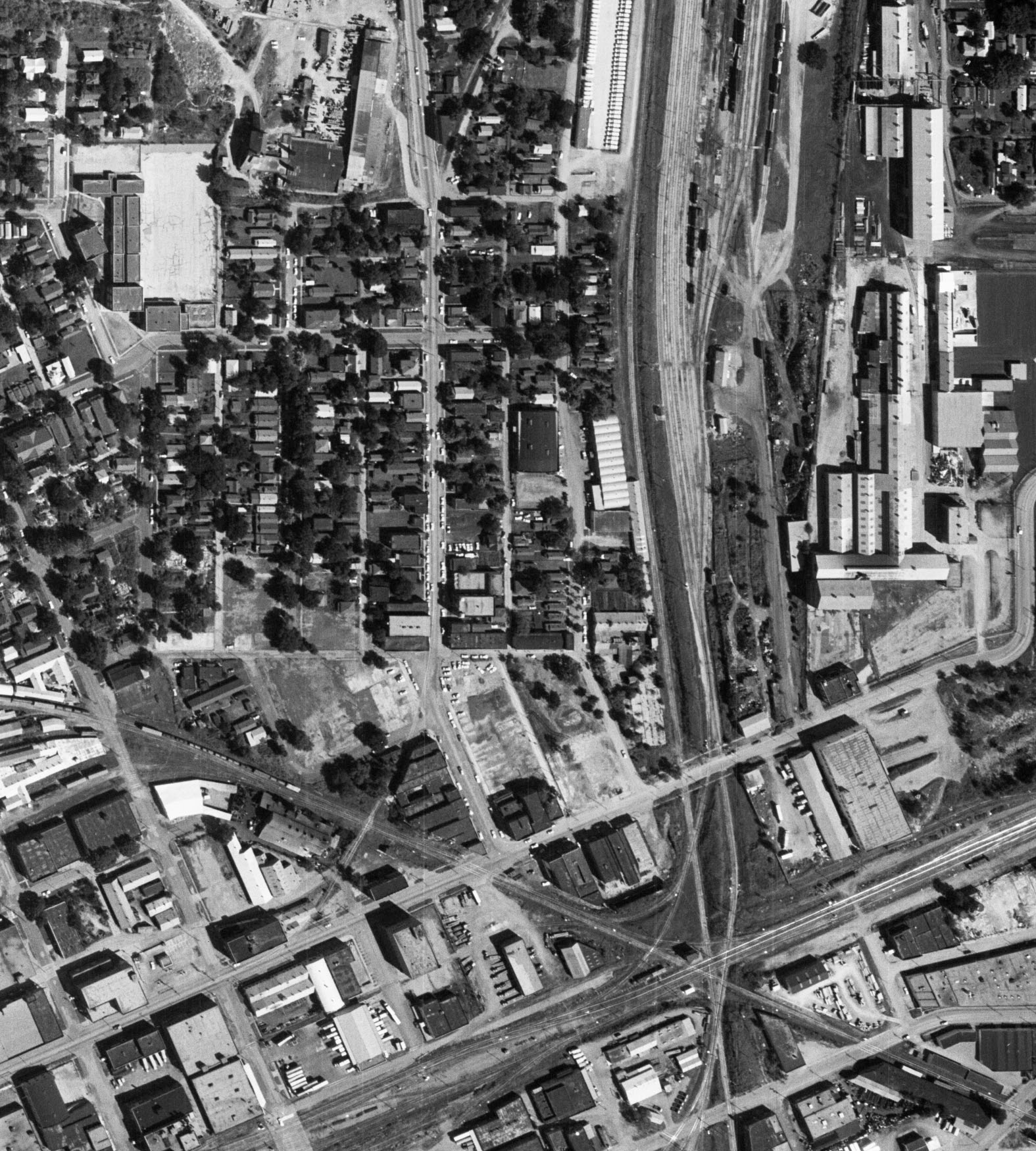"There is no Negro business district anymore"
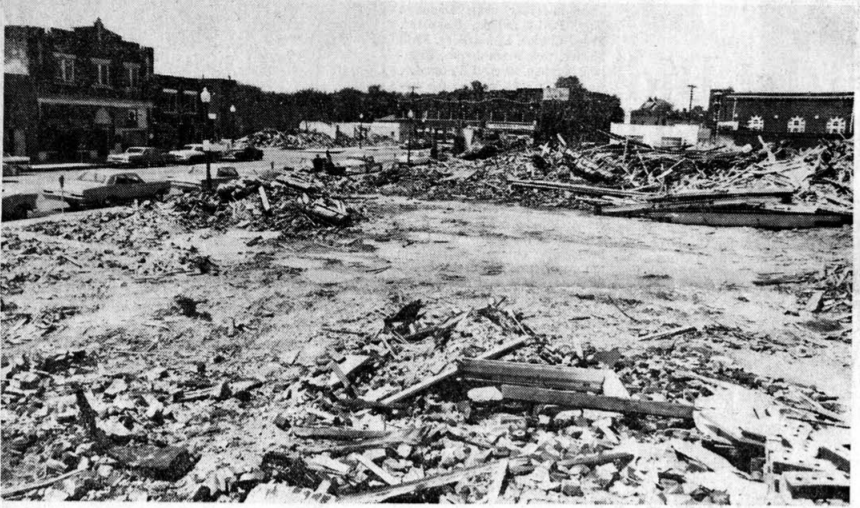
Relevant to yesterday's post on the Smithsonian Channel documentary that misrepresented the history of Greenwood, Tulsa's historic African-American neighborhood that its residents rebuilt after it was sacked and burned in the 1921 Tulsa Race Riot. The rebuilt neighborhood thrived and prospered for decades, becoming known as Black Wall Street, before urban renewal and expressway construction destroyed it again in the late 1960s. Here is a news story from the time that illustrates the social and financial impact of the decision to route the expressway through the heart of the Deep Greenwood commercial district.
From the Tulsa Library's online "vertical files," this article from the May 4, 1967, Tulsa Tribune, shows a photo of the demolition of the Dreamland Theater to make way for I-244. The story reports on the number of long-time small businesses that are closing down because they can't get financing to reopen somewhere new. Although the library's PDF has OCR text, it is full of mis-scanned words, so I decided to transcribe it here, and correlate it with other contemporaneous sources of information.
An Old Tulsa Street Is Slowly Dying
Greenwood Fades Away Before Advance of ExpresswayBy JOE LOONEY
An old man walked doen the sunny side of Greenwood Avenue and paused to stare at a pile of rubble.
Across the street, Ed Goodwin looked out the window of the offices of the Oklahoma Eagle and shook his head. "That's L. H. Williams," the Negro publisher said. "He comes down here every day. Since he had to sell out, he's just put the money in the savings and loan and lives off the interest . . ."
Ed Goodwin and L. H. Williams grew up with Greenwood Avenue. They remember the early days, when the first buildings were put up in the two blocks north of Archer Street.
They saw the riot of 1921, when many of the buildings burned. They saw the street rebuilt, grow and prosper. They saw, too, as a slum festered.
And now they are watching Greenwood Avenue die.
Its business district will be no more.
THE CROSSTOWN Expressway slices across the 100 block of North Greenwood Avenue, across those very buildings that Goodwin describes as "once a Mecca for the Negro businessman--a showplace."
There still will be a Greenwood Avenue, but it will be a lonely, forgotten lane ducking under the shadows of a big overpass. The Oklahoma Eagle still will be there, but every forecast is that some urban renewal project will push down the buildings that have not already been torn down by the wrecking crews clearing right-of-way for the superhighway.
Williams' son went to college and got a degree in pharmacy. He helped his father in the drug store, later was its manager. Today, he is looking for a job. He can't get financing to build another drug store anywhere.
"Very few of the businessmen here are able to get the financing they need to relocate," Goodwin said. "A Negro just can't do it. So, most of them are just out of business."
IT WAS BECAUSE of financing that Goodwin stayed on the street when [sic] he grew up instead of building a new office in another neighborhood.
His father operated a grocery store in a building across the street--one of those torn down to make room for the expressway.
"He built it in 1915," Goodwin recalled. "and it was destroyed in the 1921 riot. But he rebuilt and there was a grocery store there until 1930. I ran a furniture store there for a while, then put the Eagle office in there in 1936."
There, the Oklahoma Eagle remained until last year.
Goodwin owned an old theater building. It was not in the path of the highway.
"I wanted to put the paper out closer to my house, but they wanted so much money for the property, I decided it would be better to put the money into the building."
In the midst of old buildings, most of them dark, red brick structures dating to the early 1920s, he built a shining modern buff-brick structure. Behind the new building housing the Eagle, in what had been the orchestra pit of the old theater, he put a sunken garden.
OTHER PIECES of history have scattered away. There was the Dreamland Theater. J. W. Williams built it in 1916, then rebuilt it after it burned in the 1921 riot. A Negro Elks lodge moved in years ago, and this was a leading social center for the Negro community.
A rather substantial expressway pillar is slated to plunk down just about where the lobby of the theater was. The Elks managed to find a house 15 blocks up the street and there they moved a few weeks ago.
Otis Isaacs had a shoe shop next door. He rented his space from Alex Spann, who owned many of the buildings on the street. lsaacs had to shift for himself. He found a place 10 blocks away.
Attorney Amos Hall had an office downstairs. and upstairs had provided space for the Negro Masonic Lodge, of which he is Grand Master. Hall and his lodge both moved Into a building five blocks away.
BUT THE WILLLIAMS Drug is not being relocated. Nor has barber Joe Bulloch found a new place to go into business. Dr. A. G. Bacholtz has given up the private practice he carried on for so long on Greenwood Avenue, and is working with the City-County Health Department.
And Alex Spann. the building owner. He had a pool hall. With the money he got for his buildings, he bought another old pool hall a mile up Greenwood.
Hotel owner A. G. Small couldn't build another hotel anywhere. So he decided to retire. Mrs. Joseph W. Miller, whose late husband built a hotel which she operated, also could not rebuild. She, too, has retired.
A couple who operated a cafe gave up their own business and went to work for restaurants in downtown Tulsa. A man who owned a garage was just about able to get his mortgage paid off from the funds from the sale of the building to the highway department. He is not back in business anywhere else.
PAT WHITE was able to move his barbecue stand into a new home on Pine Street. The Christ Temple CME Church moved to Apache and Lewis.
"There is no Negro business district anymore," Goodwin said. Tulsa attached the name of Greenwood to the entire district occupied by Negroes--a name that ironically came from the city of Greenwood, Miss., a pIace hardly considered a Mecca for Negroes.
"They might as well take down all these parking meters," the publisher said. "There's nothing to park here for anymore."
In its heyday, it was a busy street. But the buildings grew old. The Negro population moved into newer neighborhoods. Slowly, integration opened a few doors downtown, on the other side of Archer Street. Places to eat. Go to a movie. To work at good jobs.
RAUCOUS CLUBS and rooming houses sprang up around Greenwood and Archer. Long before the expressway came and brushed the old street away, it was a dying street, like the main street of many an old, small town.
The future? A question mark for some like L. H. Williams Jr. More certain for young Jim Goodwin, who like his father became a lawyer, or for Ed Goodwin Jr., who edits the newspaper his father publishes. For others, they simply are passing from the scene, like the street they knew for half a century.
Right-of-Way for Crosstown ExpresswaySOMETIME, POSSIBLY about four years from now, an elevated eight-lane expressway will cross Greenwood Avenue between Brady and Cameron Streets.
Right-of-way for the project is now being cleared. This Tribune photo looks northwest along the construction path.
Greenwood enters the picture at the upper left, and the buildings in the right background are on Cameron.
The expressway will be about 30 feet above the ground as it crosses Greenwood.
It will carry the designation Interstate 244, and will be part of the Crosstown Expressway which forms the north side of a planned inner dispersal loop around the downtown area.
East of Greenwood, the project is taking nearly all the land between Cameron and Archer Streets as far east as the Texas & Pacific Railway (formerly the Midland valley) tracks.
The expressway will cross Archer Street and both the T&P and Santa Fe railroads east of Hartford Avenue.
West of Greenwood. the right-of-way runs northwesteriy, crossing Cameron before it gets to Frankfort Place.
Here is a section of the January 5, 1951, aerial photo showing Deep Greenwood.
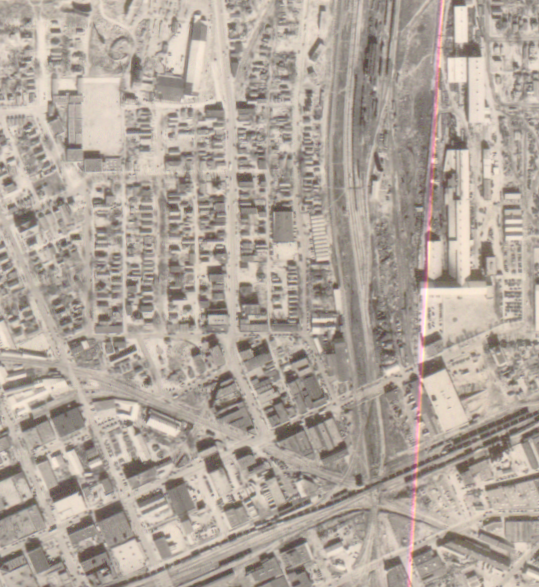
Here is the same area, from the September 10, 1967, USGS aerial photo, taken just four months after the Tribune article. As you can see, the expressway cuts right through the heart of the Black Wall Street business district. Had planners moved the expressway a block further south or perhaps built over the broad Frisco right-of-way, Greenwood would not have lost its commercial heart. Who decided the exact route is a question worth investigating.
Here is the same area as it is today, from Google Maps.
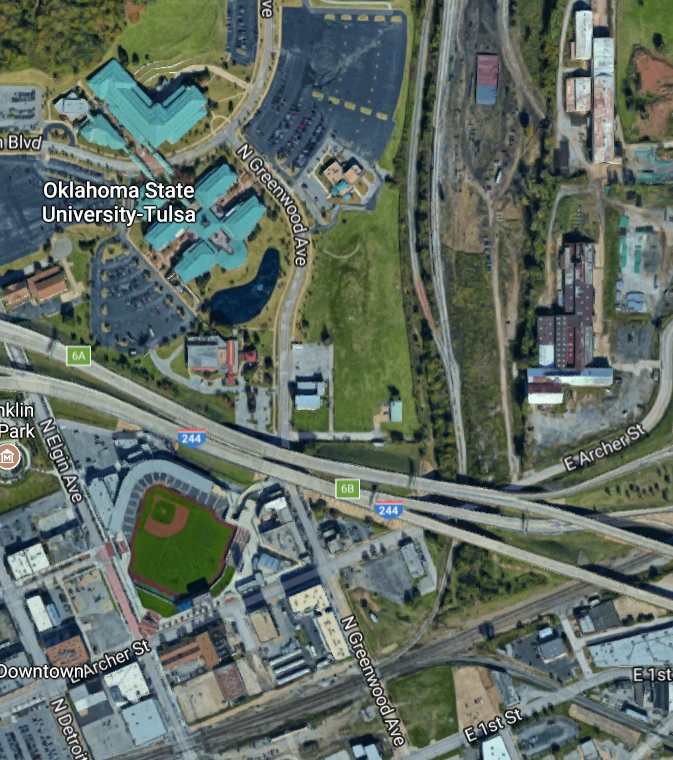
The buff-brick building mentioned in the story is still the home of the Oklahoma Eagle, at 624 E. Archer St., the SW corner of Archer and Hartford. The mention of the theater and orchestra pit on that property sent me looking: Sanborn's 1915 map shows a single-story building labeled "moving pictures" on the south side of Archer just east of the north-south alleyway that split the block; that's west of the "new" Eagle building. 1939 and 1962 maps show a two-story building, about twice as deep as the theater, with rooms on the 2nd floor and two retail spaces on the first floor.
Here is the 1962 Sanborn map covering most of the area described in the article:
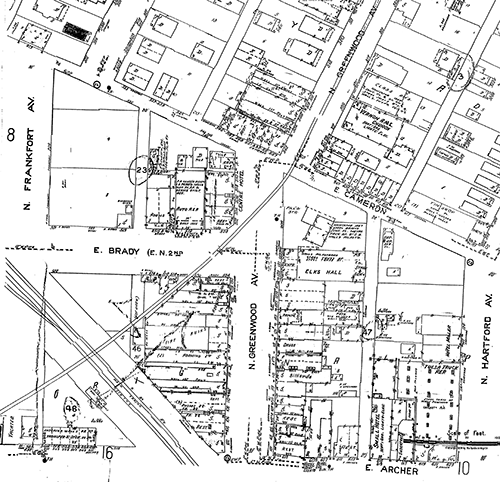
On the jump page are lists of businesses, from the 1957 Polk City Directory, on blocks that were affected by demolition. To add context, I've included buildings that were spared (at least spared by the expressway, but those buildings that were demolished for the expressway are shown in bold; italics indicates a business mentioned in the Tribune story. Even though this directory was published a decade before demolition, it's notable that so many businesses were still around 10 years later, persisting until the end. It's also notable that there were so many small, family-owned businesses and so many residences in such a concentrated area.
I suspect that by 1967, with the expressway's route having been determined for many years, other businesses shown on the lists below had already closed.
Greenwood Avenue, east side, between Archer and Cameron:
101 Georgia's Sandwich Shop
103 Frank Brown shoe shiner
105 Warren's Hotel
107 Vacant
107½ Joseph J McKeever dentist
107½ Tulsa Urban League
109 Bible Way Mission
111 DeLuxe Barber Shop
115 Alex Spann Recreation Parlor billiards
117 Harlem Barber Shop [Joe Bulloch's shop?]
117 Harlem Beauty Shop
117a Archibald G Bacoats [Bacholtz?] phys
119 Williams Drug Co
119 1/2 Cosmopolitan Lodge No 247 (BPOE) [the lodge office?]
121 Hall & Graham lwyrs
121 Preferred Risk Ins
121 Prince Hall Grand Lodge
121½ Clover Leaf Club
123 Oklahoma Eagle newspaper
123½ Everett L Hairston dentist
125 Caver French Cleaners
127 Isaac's Shoe Rebuilders
127 McGowan's Variety Store
129 Dreamland Playhouse dance hall [Elks Lodge hall]
209 Dean's Service Station No 2
Greenwood Avenue, west side, between Archer and Cameron:
102 Modern Barber Shop
102½ Robinson's Hotel
104 Yvonne's Cafe
106 State Employment Security Commission
106½ Bryant Rooms
108 Vacant
110 Art's Chili Parlor
112 Three AAA's billiards
112½ Ernestine Rooms
114 Swindall's Barber Shop
114a Dixie Cleaners
114b Henry B Swindall
116 Flamingo Club
116½ Vacant
118 Veterans Shine Parlor
120 Manhattan Hatters Cleaners
122 Warren P Carter baber
122½ Sugar Ray's Photograph Studio (Homer Ray)
124 New Welcome Grocery
124½ Smith Building
- William B Perry physician
- Sylvester E Kimbrough dentist
- Primus C Wade lawyer
- T Tyler Smith
130 J&H Fishery restaurant
130½ Melrose Rooms
202 B&R Restaurant
204 Byars Cleaners
206 H&H Shine Parlor & Shoe Market
206½ Centre Hotel
206½a Red Wing Hotel
210 Thompson Drug Store
212 Charles' Barbecue (Charles Thompson)
Archer Street, Greenwood Ave. to Iroquois Ave.:
605 Royal Hotel
607 Mid West Grocery
611 Spinner Cafe
615 Small's Hotel (three stories)
617 Jackson Funeral Home
617 Lincoln Mutual Burial Assn
619 Berry Apartments (4 units)
621 City Refuse Collection & Disposal Dept (Warehouse)
621 Sunset Cab Co
Hartford Street, west side, north of Archer:
120-124 Miller's Hotel (Joseph Miller, 2 stories)
Brady Street, Frankfort to Greenwood:
513 White Less Barbeque
515 Watson Hotel and Watson's Grill
517 Your Cab Co
Cameron Street between Frankfort Ave. and Greenwood Ave.:
503-505 Homer Miller's Rooms
515 Daniel Grocery
537 - 545 Residences
0 TrackBacks
Listed below are links to blogs that reference this entry: "There is no Negro business district anymore".
TrackBack URL for this entry: https://www.batesline.com/cgi-bin/mt/mt-tb.cgi/7163
